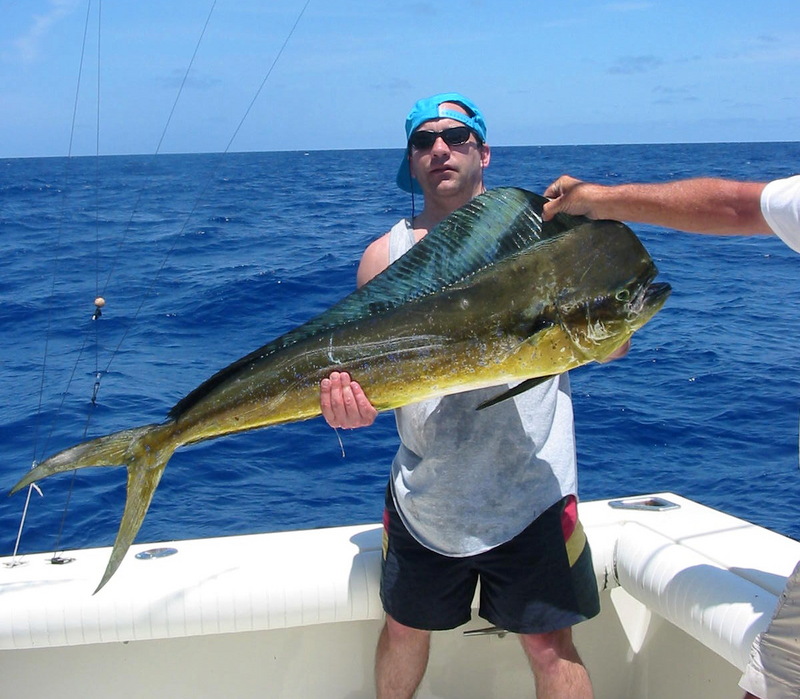|
| Query: Scomber japonicus | Result: 9th of 15 | |
Mahi-mahi, Common Dolphinfish (Coryphaena hippurus) - Wiki
| Subject: | Mahi-mahi, Common Dolphinfish (Coryphaena hippurus) - Wiki
| |

| Resolution: 1200x1048
File Size: 357289 Bytes
Date: 2004:05:11 20:15:36
Camera: Canon PowerShot A40 (Canon)
F number: f/8.0
Exposure: 1/250 sec
Focal Length: 173/32
Upload Date: 2007:08:28 23:09:37
|
Mahi-mahi
From Wikipedia, the free encyclopedia
[Photo] 28 lb bull Mahi Mahi caught in Islamorada, 2005. Author Jeff Weiss
The Mahi-mahi, Coryphaena hippurus, also known as dolphin, common dolphin-fish, dorado maverikos, or lampuki (in Maltese) are surface-dwelling ray-finned fish found in off-shore tropical and subtropical waters worldwide. They are one of only two members of the Coryphaenidae family, the other being the Pompano dolphinfish. The name "mahi-mahi" ("strong-strong" in Hawaiian), particularly used on restaurant menus, has been adopted in recent years to avoid confusing these fish with dolphins, which are mammals.
General characteristics
Mahi-mahi have a lifespan of no more than three to four years. Catches average 7 to 13 kg (15 to 28 pounds). They seldom exceed 15 kg (33 pounds), and any Mahi-mahi over 18 kg (39 pounds) is exceptional. Mahi-mahi have compressed bodies and long dorsal fins extending almost the entire length of their bodies. Their anal fins are sharply concave. They are distinguished by dazzling colors: golden on the sides, bright blues and greens on the sides and back. Mature males also have prominent foreheads protruding well above the body proper. Females have a rounded head. The males and female have similar shaped bodies except for their heads. Females are usually smaller than the males.
When they are removed from the water, the fish often change between several colors (this being the reason for their name in Spanish Dorado Maverikos), finally fading to a muted yellow-grey upon death.
Mahi-mahi is one of the fastest-growing fish. They are fast swimmers as well, with a top swimming speed of 50 knots. Mahi-mahi spawn in warm ocean currents throughout much of the year, and its young are commonly found in sargassum weed.
Mahi-mahi are carnivorous, feeding on flying fish, crabs, squid, mackerel, and other small fish. They have also been known to eat zooplankton and crustaceans.
Capture
Mahi-mahi are highly sought for game fishing and commercial purposes. Game fishery is popular due to their beauty and fighting ability. Commercially they are sought for their flesh, notable for its flavor and firm texture.
Mahi-mahi have become popular restaurant fare in many areas due to its sweet flesh flavor, sometimes eaten as a substitute for swordfish. It has scales, therefore they are kosher for Jews, as well as halal for Muslims.
Location
Mahi-mahi can be found in the Caribbean Sea, on the west coast of North and South America, and Southeast Asia as well as many other places worldwide. The United States and the Caribbean countries are the primary consumers of Mahi-Mahi products. Other developed countries in Europe are increasing their consumption every year. Japan is a strong consumer as well.
Mahi-mahi play a major role in the novel Life of Pi (they are called dorados).
http://en.wikipedia.org/wiki/Mahi-mahi
| The text in this page is based on the copyrighted Wikipedia article shown in above URL. It is used under the GNU Free Documentation License. You may redistribute it, verbatim or modified, providing that you comply with the terms of the GFDL. |
|
Comments |
|---|
| | Guest |
|
Scientific Name: Coryphaena hippurus Linnaeus, 1758
Common Names:
English – Common Dolphinfish, Dolphinfish, Dolphin Fish, Dorado, Green Dolphin, Mahimahi, Mahi-mahi, Mahi Mahi, Common Dolphin Fish
French – Clic, Coryphène Commune, Dauphin, Dorade, Dorade Coryphène
Spanish – Dorado Común, Dorado Delfin, Lampuga, Llampuga
Synonyms:
Coryphaena argyrurus Valenciennes, 1833
Coryphaena chrysurus Lacepède, 1801
Coryphaena dolfyn Valenciennes, 1833
Coryphaena dorado Valenciennes, 1833
Coryphaena fasciolata Pallas, 1770
Coryphaena immaculata Agassiz, 1831
Coryphaena imperialis Rafinesque, 1810
Coryphaena japonica Temminck & Schlegel, 1845
Coryphaena margravii Valenciennes, 1833
Coryphaena nortoniana Lowe, 1839
Coryphaena scomberoides Valenciennes, 1833
Coryphaena suerii Valenciennes, 1833
Coryphaena virgata Valenciennes, 1833
Coryphaena vlamingii Valenciennes, 1833
Ecterias brunneus Jordan & Evermann 1914
Lampugus siculus Valenciennes, 1833
Lepimphis hippuroides Rafinesque, 1810
Scomber pelagicus Linnaeus, 1758 |
^o^
Animal Pictures Archive for smart phones
^o^
|
|
|

